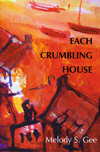Each Crumbling House
Melody S. Gee’s Each Crumbling House won the 2010 Perugia Press Prize. The volume advances the mission of the press, which “publishes one collection of poetry each year, by a woman at the beginning of her publishing career.” Each Crumbling House includes 52 poems, many of them autobiographical, in which Gee dwells on the challenges of negotiating relationships with lovers, family members, and history. Adding atmosphere and nuance to her verse, Gee’s Chinese-American heritage often haunts her speakers, as they navigate multiple continents as well as in-between spaces not found on any maps.
Throughout the collection, Gee’s handling of form is both subtle and precise. In several works, she uses lineation to explore a façade of normalcy that veils hidden tensions. Take “Fear,” which describes an encounter with a spider, breaking up regularly metered lines to convey the apprehension of the speaker—and to suggest the connection she feels with the curious, watchful arachnid:
For all its eyes, it never sees me whole,
but I am invaded.
Send it quivering
away with a breath, only to find it
later lurking in my sleeve?
Or drown it
Absence likewise matters in “A Line of Skin,” when the speaker struggles to find a word that does justice to an intimate connection with another:
—do we call it love?
in this moment heavy
with need a moment drowning
in the thought of us
do you hear the sounds of pockets
emptying?
when we let the space between
become us my lips
on the broken line of your lips
The self-referential playfulness evokes the thrill of joining with someone else. At the same time, the openness not only creates a sense of uncertainty (appropriate for an inchoate relationship), but also resists the impulse to reduce the bond between these two individuals to a single term.
Many of Gee’s poems meditate on the difficulty of making meaning with words, particularly when trying to bridge different languages. In “Southern Xi’an Road,” the speaker grapples with dissimilarities between Mandarin and Cantonese: “Their word for burning / sounds like our word for sugar.” Still, in the company of her mother, the speaker tries to purchase terracotta soldiers from the locals; the pair finds the transaction much harder to complete than they had originally anticipated: “We don’t know / how to ask in Mandarin, How much for one soldier? / Between our languages, we cannot agree / on the idea of a soldier.” The mementos are purchased, but not at a fair price, because of what is lost in linguistic negotiation.
In “What You Remember,” language is again problematic, though not ultimately necessary to bridge the distance between people of different ages and cultures. The speaker anticipates giving gifts to children in her mother’s village, suggesting the inheritance she will pass on, offering that she and the youths will “touch hands in exchange. / I will not remember how to say / the simplest words to them.”
Although Gee always displays self-awareness and formal precision, a few of the poems in Each Crumbling House are less available than others because they insist on private meanings at the exclusion of public ones. See, for instance, “Migration.” However, the majority of Gee’s works actively invite imaginative engagement from her audience, even while depicting highly personal struggles. In “Eating Bitter,” a plurality of sensations affords multiple points of entry for those aspiring to relate to the speaker:
To eat bitter, my mother
dipped her finger
in her father’s absence.
Cut her lip on the hungry
dry season of Canton.
Ate winter’s bitter melon.
She squeezed bitter from her
palms onto the bamboo
knife handle. Into the savory
and the sweet. I learned
the taste of things
was not always in the taste,
was not reason enough to dislike
or like what I ate.
Although an intimate mother-daughter relationship features prominently in the poem, it treats more than an individual’s disillusionment. The use of taste makes the scene accessible on a fundamental human level, even as it stretches the palates of most readers. Other references to food and to appetite in Each Crumbling House similarly enable the audience to become part of the confusing, multivalent scenes constructed by Gee. In “Build, Build No More,” a tangerine “shrugs off / its caving skin,” as though it was a person coming of age. In the apocalyptic “Flood,” an overflowing river resembles a monster as it devours the rice of a village; it leaves behind only “a pulp of hunger,” which represents a specific place in time (Li-Hong Lei village, China, 1957) and resembles innumerable locations throughout the ages.
Each Crumbling House is a rich collection, with a complex but consistent vision. Words from the Shakespearean epigraph of the second section intimate that Gee’s voice is not only original—despite being informed by the past—but also more than the sum of its parts: “perform an act / Whereof what’s past is prologue; what to come / In yours and my discharge.” Gee’s work will appeal to anyone interested in the politics and poetics of intercultural exchange. Readers who sojourn alongside her—ranging from California to China, across a span of several decades—will share in explorations of how to transcend boundaries between different places, people, traditions, and languages, in search of a fluid and vibrant twenty-first-century identity.





